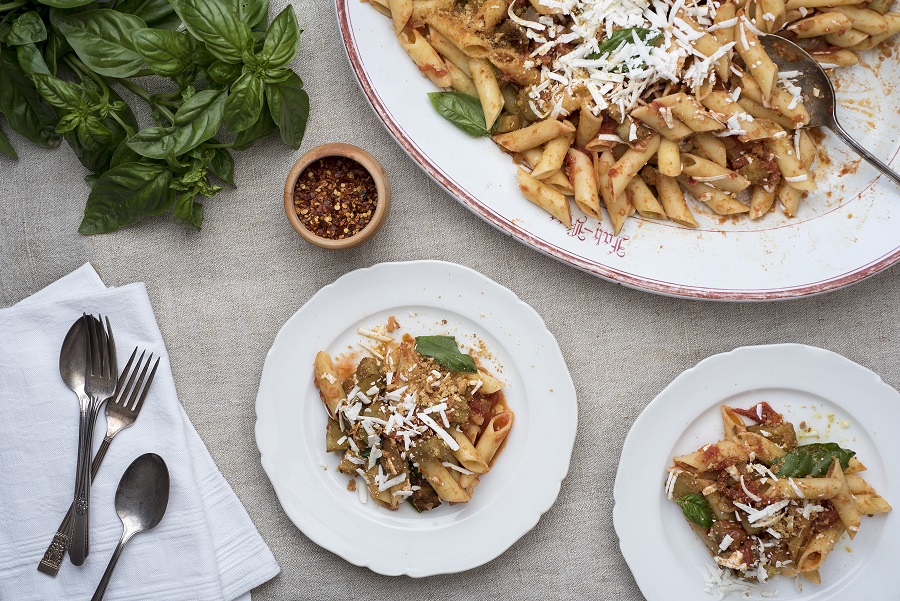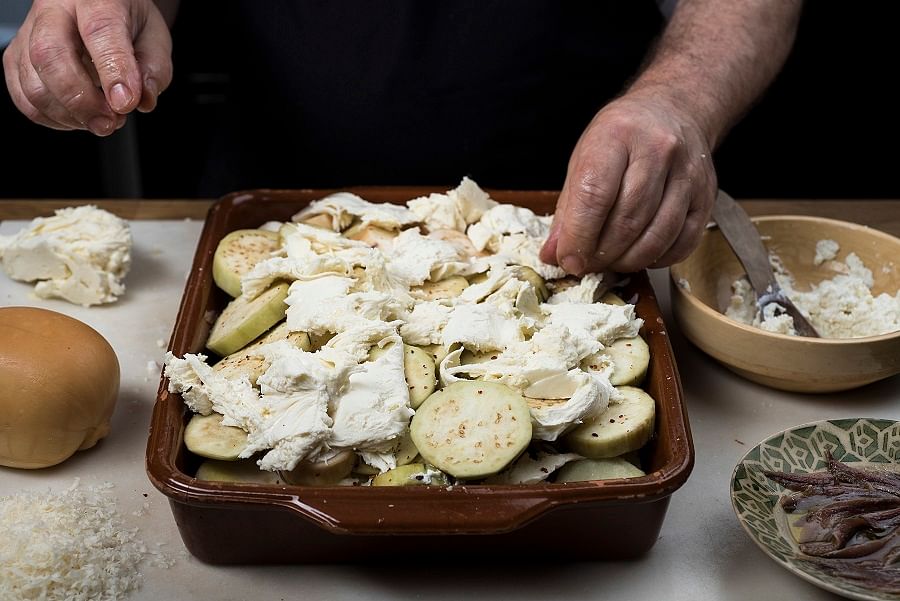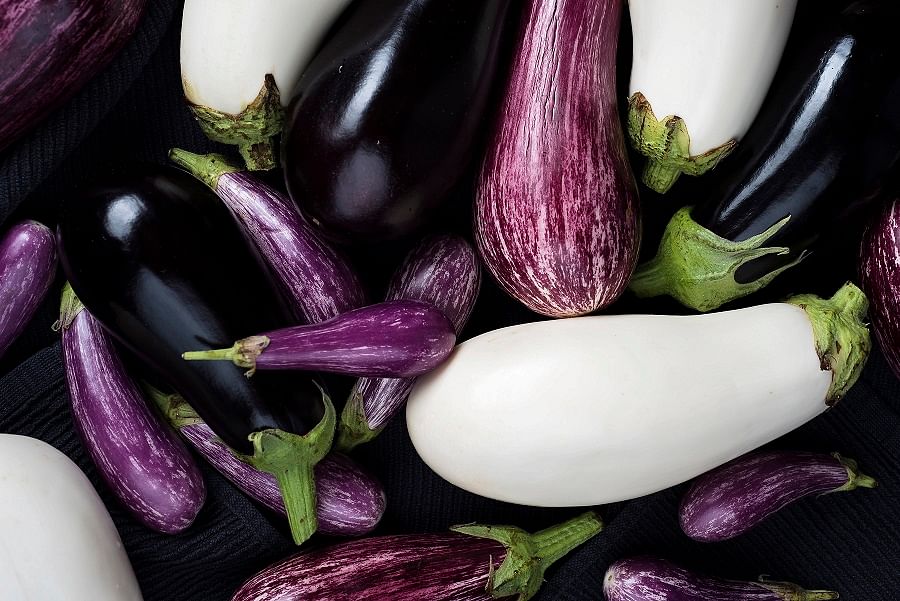Savour a slice of Sicily with three classic eggplant recipes
Eggplant, a key ingredient in Sicilian cuisine, is the star of these three classic Italian dishes.
Sign up now: Weekly recommendations for the best eats in town

Pasta alla Norma is a humble dish, yet justly famous. Fried eggplant cubes are tossed with a simple tomato sauce, pasta and ricotta salata.
PHOTO: NYT
David Tanis
Follow topic:
(NEW YORK TIMES) - It is hard to imagine Sicilian cooking without eggplant. You find it in every market, in every restaurant and certainly in every home kitchen. Having recently visited Sicily, I remember each eggplant binge fondly - and there were many.
It is always fascinating to see how cuisines and cultures collide. Sicily has been fought over and ruled by many peoples during the last 2,500 years, starting with the ancient Greeks. Each conquering group introduced ingredients from its home turf, adding layers to an ever-evolving local cuisine: The Greeks planted grapes and olives, the Romans contributed wheat.
But it wasn't until the early Middle Ages, under Byzantine and Muslim rule, that eggplant became part of the everyday Sicilian diet. Eggplant, originally cultivated in South Asia, had long been a staple of Arabic cookery; now it is popular throughout most of the Mediterranean. The Spanish introduced tomatoes and peppers from the New World, two other ingredients that now lie at the heart of Sicilian cooking.
Sicilian cuisine today is varied, with beloved regional recipes and all manner of extravagant food for feast days, as well as incredible fish and shellfish from the coastline. But a recurring theme in daily cooking is the use of a few inexpensive, common ingredients: olive oil, eggplant, tomato and pasta, usually with a pinch of peperoncino, crushed hot red pepper.
These are down-home, primal flavors, emblematic of so-called cucina povera, in which simple and delicious meals are made on the cheap. Eggplant often stands in for meat. Slices dipped in breadcrumbs and pan-fried in olive oil replace lamb chops, or are rolled with cheese to make involtini.

Eggplant salads, eggplant pickles, eggplant-heavy pasta dishes, stewed eggplant, stuffed eggplant, grilled eggplant - you find all these and more in Sicily. Three of the most famous eggplant dishes are pasta alla Norma, eggplant caponata and eggplant parmigiana.
For each, there are countless variations, sometimes vastly different one from the other. Here I offer my own take, inspired by my travels. Pasta alla Norma is humble, traditional and justly famous. The 19th-century composer Vincenzo Bellini is said to have adored it with such a passion (he ate it for lunch daily in his hometown, Catania) that the dish was eventually named after his opera "Norma."
You make a simple basil-infused tomato sauce, fry eggplant cubes in olive oil, toss both with pasta and shower with grated ricotta salata and toasted breadcrumbs. Or do you? Some cooks forgo the crumbs. Some fry large slices of eggplant and lay them over the pasta, or ring the platter with them instead.

Eggplant caponata is of Arabic origin, presumably, since it is stewed in oil, sweetened with sugar and spiked with vinegar. A kind of savory preserve, it is often made in quantity and stored in jars for use throughout the year. This one has capers and green olives, but other versions contain raisins and pine nuts; I know a cook who includes a pinch of saffron. Some cooks add a lot of tomatoes, but I prefer just a touch of tomato paste. The seasoning is sweet, sour and salty, like a good pickle. Wait to taste it a day or two after it is prepared, so the flavors can fully meld. Serve caponata on little toasts as an appetizer or to accompany a meal - or as a picnic lunch with a loaf of crusty bread.
Eggplant parmigiana is often blanketed in tomato sauce, which makes this tomato-free version, which I learned from a Sicilian cook in a small town outside Palermo, rather unusual. She makes it by layering thinly sliced eggplant with tuma (a fresh curd cheese), caciocavallo, pecorino and Parmesan; I use fresh ricotta and smoked mozzarella for a similar effect. It is a bit like a lasagna without pasta. A dozen anchovy fillets are scattered on top. Those anchovies, melted into the crisp breadcrumb-and-cheese topping, provide a sharp contrast to the sweetness of the eggplant. I like to serve it at room temperature, with a tomato salad alongside.
These dishes taste best with spanking-fresh eggplant. Seize the moment at the market.
RECIPE 1 : CLASSIC PASTA ALLA NORMA
Yield: 4 to 6 servings
Time: 30 minutes
INGREDIENTS
Extra-virgin olive oil
1 small onion, diced
Salt and pepper
2 garlic cloves, peeled
Pinch of crushed red pepper
12 basil leaves, plus a few basil sprigs for garnish
4 cups peeled, chopped tomatoes with juice, fresh or canned
3 or 4 small eggplants, peeled and cut into 2.5cm cubes
450 pasta, such as penne, rigatoncini or spaghetti
1 cup coarsely grated ricotta salata
1/4 cup toasted breadcrumbs, preferably homemade
METHOD
1. Make a quick tomato sauce: Put 2 tablespoons olive oil in a large, deep skillet over medium-high heat. Add onions, season with salt and pepper and cook, stirring occasionally, until softened, about 10 minutes.
2. Stir in garlic, red pepper and basil leaves and cook for 1 minute. Add tomatoes, stir and bring to a simmer. Reduce heat to low and let sauce simmer gently for 20 minutes, until slightly thickened. Taste and adjust seasoning. Set aside. (Sauce may be prepared up to 2 days in advance.)
3. Meanwhile, bring a large pot of well-salted water to a boil. Turn heat to low and cover pot until it's time to cook the pasta.
4. Put a wide cast-iron pan over medium-high heat. Add 4 tablespoons olive oil to coat surface of pan. When oil is wavy, test by adding a cube of eggplant. It should begin to sizzle and brown immediately. Fill the pan with a single layer of eggplant cubes. Turn eggplant with a spatula or tongs and brown nicely on all sides. Lower heat as necessary to maintain an even temperature; if the pan is too hot, the eggplant will burn.
5. Remove cooked eggplant to a plate and continue to fry remaining eggplant in batches, adding more oil as necessary. Season finished eggplant with salt and pepper. (Alternatively, roast the eggplant on a baking sheet at 400 degrees, lightly drizzled with oil, until cooked and nicely browned, about 20 minutes.)
6. To assemble and serve, boil pasta until al dente, leaving it a little firmer than normal. Bring the tomato sauce to a simmer. Add eggplant to sauce and gently stir to combine. Reserve a cup of pasta cooking water, then drain pasta and add to sauce. Using 2 wooden spoons or tongs, toss pasta and sauce, and let cook 1 minute more. Thin sauce if necessary with a little pasta cooking water.
7. Transfer to a warmed wide pasta bowl. Sprinkle with grated ricotta salata and breadcrumbs. Garnish with torn or whole basil leaves and a drizzle of olive oil, if desired. -
RECIPE 2: EGGPLANT CAPONATA
Yield: 6 or more servings
Time: 1 hour, plus 1 hour to mellow
INGREDIENTS
Extra-virgin olive oil
3 or 4 small eggplants, peeled and cut into 2.5cm cubes
Salt and pepper
1 onion, chopped
4 small celery stalks, chopped (about 1 cup), blanched for 1 minute in boiling salted water, then cooled
1 tablespoon tomato paste
2 tablespoons capers, rinsed
1 cup good-quality green olives, pitted
Pinch of crushed red pepper
1 bay leaf
3 tablespoons granulated sugar
1/4 cup red wine vinegar
1/2 cup dry white wine
2 tablespoons chopped parsley
METHOD
1. Put a wide cast-iron pan over medium-high heat. Add 4 tablespoons olive oil to coat surface of pan. When oil is wavy, test by adding a cube of eggplant. It should begin to sizzle and brown immediately. Fill the pan with a single layer of eggplant cubes. Turn eggplant with a spatula or tongs and brown nicely on all sides. Lower heat as necessary to maintain an even temperature; if the pan is too hot, the eggplant will burn.
2. Remove cooked eggplant to a plate and continue to fry remaining eggplant in batches, adding more oil as necessary. Season finished eggplant with salt and pepper. (Alternatively, roast the eggplant on a baking sheet at 400 degrees, lightly drizzled with oil, until cooked and nicely browned, about 20 minutes.)
3. Meanwhile, heat 2 tablespoons oil in a stainless-steel skillet over medium-high heat. Add onions, season lightly with salt and cook, stirring, until softened and lightly colored, about 5 minutes. Stir in blanched celery, tomato paste, capers and olives. Add crushed red pepper, bay leaf, sugar, vinegar and wine. Simmer for 5 minutes.
4. Gently fold in cooked eggplant and simmer 2 or 3 minutes more. Taste cooking juices and adjust salt if necessary. Let mellow for 1 hour at room temperature (or make it a day in advance for fuller flavor). Sprinkle with parsley to serve. The caponata will keep for a week, refrigerated.
RECIPE 3: BAKED EGGPLANT WITH RICOTTA, MOZZARELLA AND ANCHOVY
Yield: 6 to 8 servings
Time: 2 hours
INGREDIENTS
Extra-virgin olive oil
3 or 4 small eggplants, peeled and cut into 1cm slices
Salt and pepper
Pinch of crushed red pepper
1 small red onion, thinly sliced
12 ounces fresh ricotta
1/2 pound smoked mozzarella, thinly sliced (or use fresh mozzarella)
2 cups provolone cheese, coarsely grated (about 1/2 pound)
1/2 cup finely grated Parmesan or Grana Padano cheese (about 2 ounces)
1/2 cup finely grated pecorino cheese (about 2 ounces)
12 anchovy fillets
1/4 cup toasted breadcrumbs, preferably homemade
1 teaspoon dried oregano, preferably Sicilian
METHOD
1. Heat oven to 375 degrees. Generously oil a 9- by 13-inch baking dish. Season eggplant slices on both sides with salt and pepper. Arrange half the eggplant slices in one layer on bottom of dish, overlapping slices slightly. Drizzle or paint eggplant generously with olive oil. Sprinkle with crushed red pepper to taste and scatter onion slices evenly over surface
2. With a small spoon, distribute the ricotta in little blobs evenly over surface, then arrange half the smoked mozzarella over the ricotta. Sprinkle with 1 cup grated provolone.
3. Make another layer of overlapping slices with remaining seasoned eggplant. Drizzle or paint eggplant generously with olive oil. Top surface evenly with remaining smoked mozzarella and provolone, then sprinkle with Parmesan and pecorino. Arrange anchovy fillets over top and sprinkle with breadcrumbs.
4. Bake uncovered for 45 minutes to 1 hour, until eggplant is quite tender when pierced with a fork and top is crisp and golden. (If top seems to be browning too quickly, tent with foil and reduce heat to 350 degrees.) Remove from oven, dust with oregano and let rest at least 20 minutes before cutting into squares. The dish is best served at room temperature, not piping hot.
AND TO DRINK ...
While eggplant is a central ingredient in each of these recipes, the different preparations suggest different wines. The pasta alla Norma will go best with a good red that is fruity but not too fruity, acidic but not too acidic. I thought first, naturally, of a Sicilian red, either a nerello mascalese from the Mount Etna region or a fresh frappato from the Vittoria area. A dolcetto from northwestern Italy would also work well, as would a fresh, restrained zinfandel. The sweeter caponata, if you are serving it with toast or solo, would go well with a dry rosé or an incisive white, like an Etna Bianco, made of the carricante grape. While the baked eggplant would also go well with one of the Sicilian reds I suggested, a good Chianti Classico would be delicious.

